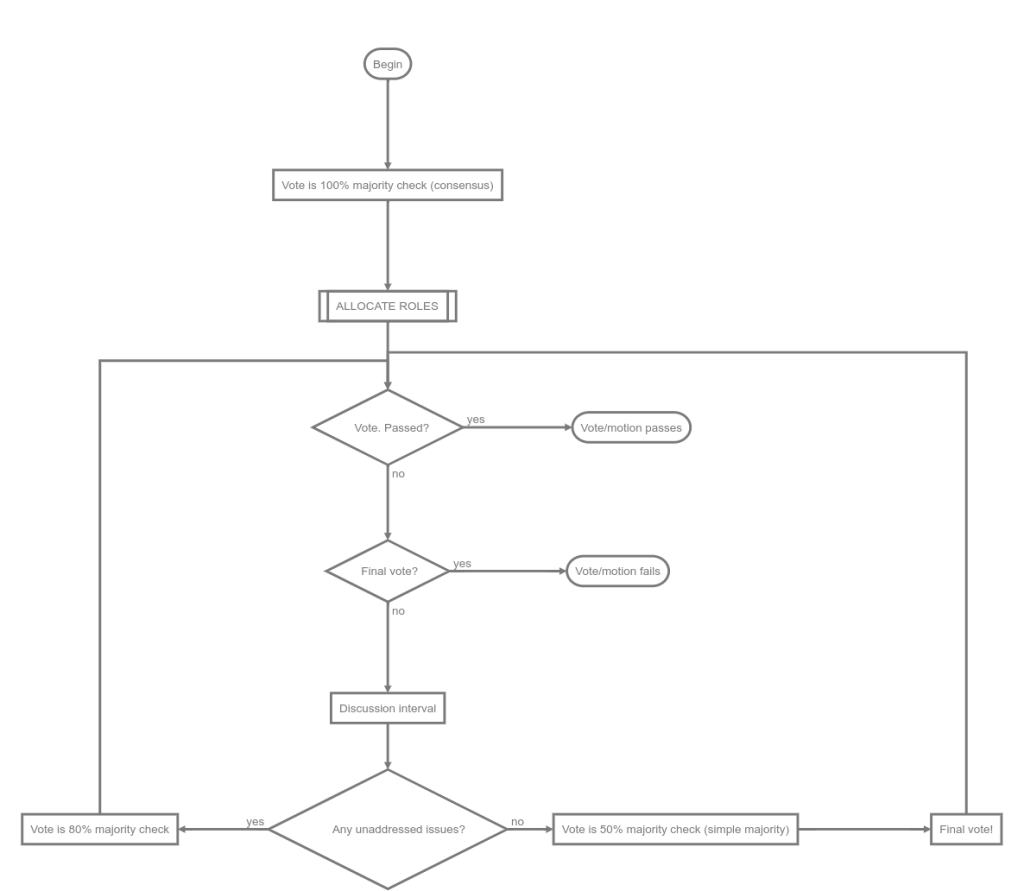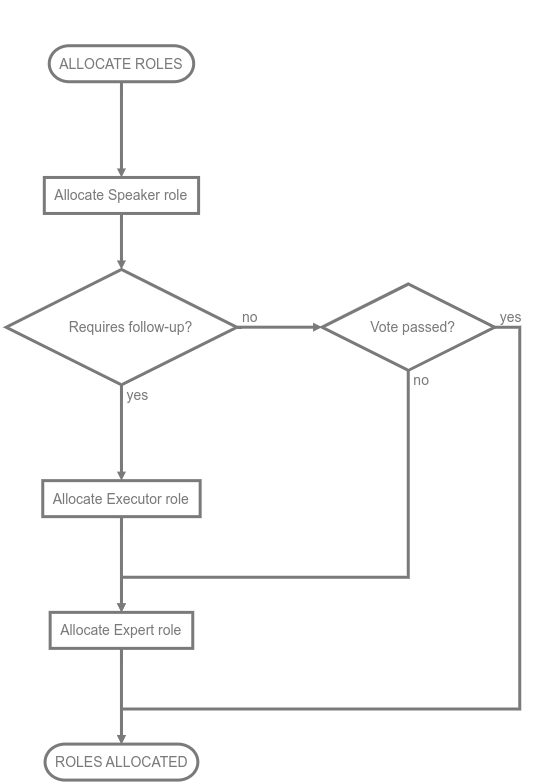¶ Recomposition Collective Voting and Decision-Making Outline
Iteration 2.1
May 2024
¶ What Requires a Vote?
¶ Examples
This is an inexhaustive list of types of things which require a vote:
- Changes to core documents require a vote, as established in the charter.
- Allocating or reallocating funds, initiating new transactions outside of allocated funds, initiating recurring payments, etc.
- Corrective action toward a member requires a vote, either to enact or, in the case that the Monitors deemed it necessary to perform rapid action, to confirm or cancel the Monitors' decision.
- Adding a new member to or removing a member from a Delegate Circle or other Delegation.
- This does not apply if the delegation was set to expire after a certain condition was met or time period elapsed.
¶ Anti-Examples
And this is a likewise-inexhaustive list of types of things which don't require a vote:
- Forming or dissolving a work group.
- Initiating a new project.
- Any decision made as a part of a work group that falls entirely within the purview of that work group, if that work group doesn't require a vote for such things.
- Many other things.
¶ Consensus
Consensus voting involves all members who wish to do so casting votes during one or more cycles of a specified voting period (e.g. "24 hours").
¶ Roles
Before the first vote, a number of roles must be allocated. The roles that may be allocated are:
- Speaker:
- The Speaker exists to ensure everyone is heard, and everyone with issues is specifically prompted to speak on them.
- If people need time to think, it's the Speaker's job to make sure they are prompted again, and their concerns are eventually heard.
- Additionally, it is the Speaker's job to ensure the discussion remains civil.
- Expert:
- The Expert is the person with the most relevant knowledge to the subject (who was not directly involved in the subject of the vote).
- It is their job to combine together all perspectives into a coherent plan, in the case that a plan is necessary for the subject of the vote.
- They are in charge of determining how issues with the subject of the vote are addressed after a discussion phase.
- Executor:
- The Executor is tasked with following up after the vote, and ensuring the plan created by the Expert is actually followed and enacted.
If the vote will not require any further action after the vote, the Executor may not be necessary. If any members feel that this role is necessary, it is deemed necessary.
Members may hold off on allocating an expert until such time as the vote fails, if selecting an Executor is deemed unnecesarry.
¶ First Voting Cycle
Members each cast votes of either For, Against, or Abstain (although they may also simply not vote, which is functionally the same as Abstaining).
- If, after the first cycle, there are no Against votes and at least one For vote, the vote passes.
- If there are any Against votes, a discussion interval occurs.
¶ Discussion Intervals
At the beginning of discussion intervals, each member who voted Against decides whether their issue/issues is/are a "dealbreaker" issue (that is, an issue on which basis you are unable to agree with the subject of the vote unless it is changed or removed entirely), or merely a request for clarification or some possible changes.
Then, the members with issues note their issues with the subject of the vote, and form groups by issue (if any members have multiple issues, they may, of course, be in multiple groups. This option unfortunately functions much more effectively online than in person). Dealbreaker issues and non-dealbreaker issues must be in separate groups, even if the issues themselves are similar.
The Groups each decide internally what amendments to and/or clarifications of the proposal must be made to assuage their issues, then nominate a member from their respective group to explain their issue to the assembled members.
If this is the first discussion interval, the nominated members with dealbreaker issues explain their issues, but do not participate in the following discussion section with the member(s) who put forth the vote and the Expert.
For each issue, the nominated member and the member(s) who put forth the vote discuss the issue, and the Expert then decides if and how to amend the vote to fix the issue.
Then, another voting cycle occurs, this time with a slightly less restrictive requirement for passing.
¶ Falling Vote Percentages
The first voting cycle requires a 100% consensus to pass. Following votes, however, have less strict requirements.
The second voting cycle requires an 80% consensus to pass, meaning if 80% or more of the non-Abstain votes are For, the vote passes. If the second or later voting cycle fails (other than the final voting cycle), another discussion interval occurs.
If there were no remaining issues to address in this vote's preceding discussion interval, this is the final voting cycle. The final voting cycle requires a 50% simple majority to pass, and if it fails, the vote is concluded as failing.


¶ Sortition
Sortition is the process of drawing lots to fill a role or set of roles.
- In a physical use-case, all members draw lots from a covered container to determine role allocation.
- In a digital use-case, all members' names are placed in a list, and each role is selected randomly from the list in turn, with those who have already been allocated a role in that sortition being excluded from the remaining role selections.
¶ Conflicts of Interest
In role selections (both via Sortition and by other methods), any members (including the members in question) may point out a conflict of interest a member has with the role they are sorted into, and if any members do, all members in attendance engage in a Short* Simple Vote on whether or not the conflict of interest in question is sufficient to pass over the member in question for the role.
*Short vote: The vote in question has no minimum voting period, but instead takes as long as it takes for all involved members to cast their votes, up to a maximum of 30 minutes.